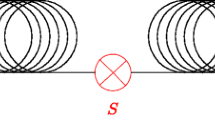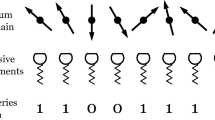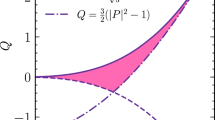Abstract
Using the trajectory conception of state, we give a simple demonstration that the quantum state of a many-body system may be expressed as a set of states in three-dimensional space, each associated with a different particle. It follows that the many-body wavefunction may be derived from a set of waves in 3-space. Entanglement is represented in the trajectory picture by the mutual dependence of the 3-states on the trajectory labels.
Similar content being viewed by others
Avoid common mistakes on your manuscript.
Motivation for the spatial trajectory conception of the quantum state
A curious dichotomy between theory and practice pervades the history of quantum mechanics. On the one hand, the theory is supposed to be about ‘measurements’, procedures whose outcomes are the eigenvalues of self-adjoint Hilbert space operators that represent the observables ‘measured’. The role of the ‘state’ of a physical system, a vector ψ(x) (in the position representation) in the Hilbert space, is to encode the probabilities of the empirical outcomes. The ψ conception of state has been adopted almost universally since the advent of quantum theory. Both the formalism and the debates over the theory’s meaning are routinely couched in its terms, including by those who seek to discern causal mechanisms underlying the statistical ψ calculus.
On the other hand, in real laboratories rather than in theoreticians’ heads, measurements are about the determination of position—of a meter pointer, of a symbol in a printout, of an oscilloscope track, ... The statistical regularities predicted by the theory are tested, in the end, by sequences of individual position experiments (amplified to the macroscopic level). Empirical physical assertions about a quantum system are either about or are inferences from the measurement of position. When we ‘measure spin’ we infer that quantity from the discrete spatial domains impacted by a beam of identically prepared systems on a detecting screen, with the cumulative density of the successive impacts indicating the probability distribution. For all the talk of operators, Hilbert space and entanglement, we have to map our abstract multidimensional theoretical analysis into assertions about the (likely) locations of moving objects in three-dimensional physical space; that is, in the first instance, into statements about three-dimensional trajectories.
The following question therefore presents itself: if our direct connection with the ‘quantum world’ is through the time-varying positions of objects in physical 3-space, in which the objects may legitimately be regarded as part of an ecumenical quantum description even if they comprise macroscopic components, why is the theory not formulated directly in these terms, that is, why is the quantum state not a time-dependent position variable rather than merely a time-dependent encoder of the statistics of position? To couch the theory directly in terms of experimental outcomes would, after all, chime with the instrumentalist views that have dominated most quantal discourse.
Of course, these are contentious issues. But it turns out that the basic problem that emerges from these considerations—that of representing the quantum state using position as the state variable—has a simple and apparently uncontentious solution [1] (see [2] for a recent account and further references, and see [3] for a discussion setting the theory in a wider conceptual and historical context). In fact, the model we propose accounts for more than just empirical variables; it provides an alternative conception of the quantum state in general processes, measurements or otherwise. Moreover, the two state pictures, the wavefunction and the trajectory, are not in conflict; they stand in a harmonious complementary relation of codetermination. The wavefunction formulation describes temporal changes in the system’s state at each space point (analogous to the Eulerian picture in fluid mechanics), and the trajectory formulation describes the transport of the system’s state across space (analogous to the fluidical Lagrangian picture). In particular, the paths are conveyors of constant parcels of probability. This extension of the notion of state raises interesting questions about how quantum processes may be comprehended but our objective here is more modest: to highlight that, according to the alternative trajectory formulation, the quantum state of an n-body system may be expressed as a set of n three-dimensional states, one 3-state being associated with each of the n particles (this formulation is a special case of the trajectory theory developed for a generalized Riemannian configuration space [4]). Merging aspects of both conceptions of state implies a corresponding three-dimensional decomposition of the ψ version, a construction that has hitherto proved elusive. Entanglement is represented in the trajectory picture by the mutual dependence of the 3-states on the trajectory labels. We do not go further here into other potential roles for the trajectories, such as supporting the flow of matter or enabling causal representations of microprocesses.
Transformation of Schrödinger’s equation into the trajectory picture
A straightforward way to obtain the trajectory theory of the quantum state is to transform the independent variables xi in the Schrödinger equation for a particle of mass m in a potential V and wavefunction ψ(x, t),
into dependent variables xi = qi(a, t), i = 1, 2, 3, defined by the integral curves of the velocity vector field: ∂qi/∂t = m−1∂S/∂xi|x = q(a, t), where S is the phase (\( \psi =\sqrt{\rho }{e}^{iS/\mathrm{\hslash}} \)) and ai = q0i is the initial position. The initial condition ψ0(x) is transformed similarly. The single-valuedness of the velocity field implies that the trajectories are uniquely labelled by ai, the variation of which generates a differentiable congruence of spacetime trajectories qi(a, t). The wave equation may be recast as a self-contained dynamical equation describing the evolution of the displacement vector qi as a function of ai and t, supplemented by the appropriate initial conditions corresponding to the initial condition ψ0. The quantum state is then represented by the nondenumerable set of trajectories qi(a) occupying the space where ψ(x) is finite together with initial conditions on their density and velocity.
This transformation has been examined in detail elsewhere [1, 2], so we shall just state the results. The Schrödinger equation for qi has first- and second-order versions (in time). The first-order form is the integro-differential equation
This is less useful computationally but important in the formal structure of the theory. Differentiating (2) with respect to t yields the equivalent local second-order form, a version of Newton’s second law:
In these expressions, i, j, k,… = 1, 2, 3. The derivatives with respect to qi are shorthand for derivatives with respect to ai via the formula
where
and Jij is the adjoint of the deformation matrix ∂qi/∂al with
Finally,
is the quantum potential with
The initial data to be appended to the dynamical Eqs. 2 and 3 is
Conversely, version (1) of the Schrödinger equation may be derived from (2) or (3) together with the initial data (9) [1]. The wavefunction constructed from a solution qi is given, in polar form, by
(for the determination of the function f(t), see [1]).
A fundamental property of the dynamical Eqs. (2) and (3) is that the probability is conserved along their solutions:
We assert that at time t the congruence of trajectories qi(a) constitutes the spectrum of possible outcomes of a position measurement, with the trajectory density reflecting the quantal probability density. This is easily confirmed by applying the theory to a typical measurement process. As to which trajectory is manifested as the outcome of an individual measurement, and how it is connected to corporeal matter, are issues that require further interpretative analysis. These problems have in fact been solved but the validity of the trajectory concept of state is not dependent on a particular interpretation of quantum mechanics. We note also that the notion of a trajectory possessing simultaneously well-defined values of position (qi) and momentum (\( m{\overset{\cdot }{q}}_i \)) is not in conflict with the uncertainty relations, which comprise correlations in the statistical scatter of sequences of measurement results.
A more elegant approach to the trajectory theory, which brings out several important formal aspects of the approach, is to introduce vector potentials for the wavefunction [2]. These potentials form a set of phase space variables from which the trajectory description is obtained by a canonical transformation. This construction indicates that the connection between the two versions of state is not one-to-one; there is a gauge freedom in the trajectory equations, a relabelling transformation of the orbits, with respect to which the ψ formalism is insensitive.
Representation of the many-body quantum state in terms of functions in 3-space
A system of n particles with masses mr, r = 1, …, n, has an associated wavefunction ψ(x1, …, xn) defined in a 3n-dimensional configuration space where xri, i = 1, 2, 3, represents a set of rectangular Cartesian coordinates. The dynamical equation in this formulation is
In a straightforward generalization of the single-body theory of the last section, the n-body quantum state may be pictured alternatively as a (single-valued) congruence of curves qri(a1, …, an) in the 3n-dimensional configuration space where the indices r,i collectively range over 3n values, the arguments a1, …, an uniquely label the initial positions qr0i = ari, and the initial density and velocity are specified in accordance with ψ0 [1, 2, 4]. From the grouping of the indices, we see immediately that in this picture each configuration space trajectory is composed of n trajectories in three-dimensional physical space, the rth trajectory being given by the position vector qri. The whole nondenumerable configuration space congruence is therefore composed of n families of trajectories in 3-space. The n-body quantum state may be represented as a collection of n states in 3-space.
Note that the trajectories comprising each of the n 3-families may cross the same spacetime point, as may trajectories drawn from different 3-families.
As in the one-body case, we can give self-contained first- and second-order renditions of the trajectory version of the many-body wave equation. For the second-order variant, the Schrödinger equation becomes a set of n Newton-like equations describing the coupled evolution of the set of n displacement 3-vectors:
with initial conditions
Here we employ generalizations of the formulas (4)–(8) obtained by extending the index range. The wavefunction may be constructed from the solutions to (13) as follows (an obvious generalization of Eq. (10)):
From (13), it is evident that the trajectory qri is generally coupled with all the other current locations \( {q}_{r^{\prime }i} \), r′ ≠ r. Hence, if one family of trajectories, say the rth, is acted upon by an external force, the whole congruence will generally respond simultaneously to the localized influence. This is how nonlocality is expressed for this notion of state.
Each 3-trajectory is identified by the parameters ari = qr0i. The initial velocity (14) of each trajectory generally depends on all the parameters a1, …, an and, as time progresses, each function qri, r = 1, …, n, may become dependent on the labels \( {a}_{r^{\prime }i} \) of the other 3-trajectories r′ ≠ r due to coupling induced by the dynamical equations. This mutual dependence is how the trajectory model manifests entanglement of the n-body wavefunction. We can establish this connection by demonstrating the equivalence of the conditions for independence in the two pictures:
Theorem of independence: The wavefunction factorizes into a product of n 3-factors,
if and only if the corresponding 3-space vectors are mutually independent and ρ0 factorizes:
Proof: Equation (16) implies that the total phase is additive: \( S\left({x}_1,\dots, {x}_n\right)={\sum}_{r=1}^n{S}_r\left({x}_r\right) \). From (15), this implies that \( {\overset{\cdot }{q}}_{ri}={F}_i\left({q}_r\right) \) whose solution qri depends just on the parameters qr0i = ari. Hence, the first condition in (17) is obeyed and the second condition follows from (16). Conversely, qri = qri(ar) implies that \( {\sum}_{r=1}^n{\left.{m}_r{\overset{\cdot }{q}}_{ri}\left({a}_1,\dots, {a}_n,t\right)\right|}_{a_r\left({x}_1,\dots, {x}_n,t\right)}= \) \( {\sum}_{r=1}^n{\left.{m}_r{\overset{\cdot }{q}}_{ri}\left({a}_r,t\right)\right|}_{a_r\left({x}_r,t\right)} \) and \( J\left({a}_1,\dots, {a}_n\right)={\prod}_{r=1}^n{J}_r\left({a}_r\right) \), so, using the second relation in (17), we obtain (16) from (15). □
Applying the conditions of the theorem, (13) and (14) yield n copies of the 1-body formulas.
We can devise hybrid models of the quantum state that mix aspects of both the wavefunction and trajectory approaches by evaluating a selection of arguments of ψ in (15) along the trajectories and leaving others as space coordinates. For example, the state may be represented as a space function of just one particle’s coordinates, say xri:
Inverting, we can derive ψ from a 3-space function: ψ(x1, …, xn, t) = \( {\left.{\phi}_1\left({x}_1,{a}_1,\dots, {a}_n\right)\right|}_{a_r\left({x}_1,\dots, {x}_n,t\right)} \). In a more symmetrical representation,
Thus, the wavefunction of an n-body system may be derived from the superposition of n ‘single-particle’ functions in 3-space. Actually, we can remove all reference to x and give an alocal representation of ψ:
The hybrid wave equations obeyed by the wavefunction when various sets of xris are evaluated along trajectories are easily found by transforming the Schrödinger equation appropriately (for the single-body case, see [5]).
We have seen that the trajectory construction provides a solution to the old problem of representing a many-body system in terms of a set of ‘local’ functions, one for each particle [6]. The usual way to associate a state with one particle in a many-body system, say the rth, is to employ the partial density matrix obtained by integrating the pure state density matrix over all coordinates except xri. This definition is justified insofar as the partial density matrix accounts for measurements of operators pertaining just to the rth particle, and it defines a conserved density. However, the set of n single-body reduced matrices obtained for the whole system does not contain sufficient information to reconstruct the pure state ψ and hence this method is not the basis of an alternative three-dimensional representation of the state. Other methods of three-dimensional representation have been tried, motivated in part by a desire to avoid quantum nonlocality (e.g., [7] and references therein). As we have seen, that quest is unattainable; each 3-state generally depends on the 3n − 3 parameters defining the remainder of the many-body system. Except for the special case treated in the independence theorem above, the configuration space is irreducible and so, whatever formulation is used to represent the quantum state, nonlocality is a generic feature. One cannot remove the irreducible configuration-space dependence of quantum many-body systems by a change of coordinates, as remarked previously [6].
Identical particles
The use of symmetric or antisymmetric wavefunctions to treat a system of identical particles is generally considered to render the formalism bereft of any means of labelling or distinguishing the individual particles. In contrast, in the trajectory formulation, the rth particle in a system of n identical particles is distinguished by the temporal continuity of the rth family of orbits qri(t). Identity is expressed through symmetry properties of the trajectories: under exchange of the rth and r′th labels, the many-body state obeys the relation
together with symmetrization of the initial conditions (14). The symmetry constraints are reflected in the spatial characteristics of the paths generated by inter-trajectory forces. According to this model, ‘identical’ and ‘distinguishable’ are compatible notions.
Conclusion
The trajectories we have introduced are structures that may be discerned in the wave field, that is, lines of probability flow. But they are not just aspects of the field; the trajectories provide, together with the appropriate initial conditions for their density and velocity, an alternative conception of the state of the system so that the wave amplitude may be dispensed with and regarded as a derived quantity. The two pictures provide mutually illuminating ways of seeing a single system, each bringing out aspects not present, or only hinted at, in the other. For example, the second-order trajectory dynamical equation makes explicit reference to force as the propeller of quantum propagation, a notion that features only indirectly in the wavefunction approach. Here we also observed that, in the alternative description, the state of an n-body system is a set of n families of interlacing spacetime trajectories, and that such a notion is compatible with the quantum concepts of entanglement and identity.
References
Holland P (2005) Ann Phys (NY) 315:505
Holland P (2017) In: Kastner RE, Jeknic-Dugic J, Jaroszkiewicz G (eds) Quantum structural studies: classical emergence from the quantum level. World Scientific, London
Bokulich A (2018) In: Saatsi J, French S (eds) Scientific realism and the quantum. Oxford University Press, Oxford
Holland P (2005) Proc R Soc A 461:3659
Tokatly IV (2007) Phys Rev B 75:125105
Holland PR (1993) Sect. 7.7. In: The quantum theory of motion. Cambridge University Press, Cambridge
Freistadt H (1957) Nuovo Cimento 5(Suppl.1):1
Author information
Authors and Affiliations
Corresponding author
Additional information
This paper belongs to Topical Collection International Conference on Systems and Processes in Physics, Chemistry and Biology (ICSPPCB-2018) in honor of Professor Pratim K. Chattaraj on his sixtieth birthday
Rights and permissions
Open Access This article is distributed under the terms of the Creative Commons Attribution 4.0 International License (http://creativecommons.org/licenses/by/4.0/), which permits unrestricted use, distribution, and reproduction in any medium, provided you give appropriate credit to the original author(s) and the source, provide a link to the Creative Commons license, and indicate if changes were made.
About this article
Cite this article
Holland, P. Three-dimensional representation of the many-body quantum state. J Mol Model 24, 269 (2018). https://doi.org/10.1007/s00894-018-3804-7
Received:
Accepted:
Published:
DOI: https://doi.org/10.1007/s00894-018-3804-7




